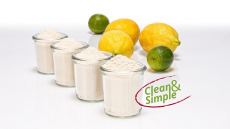New technique opens up supply of sweet potato ingredient
becoming available as of today, thanks to a new process developed
by USDA that retains nutritional and sensory properties.
Scientists from the USDA's Agricultural Research Service (ARS), working with researchers from North Carolina State University (NC State) in Raleigh and the Industrial Microwave Systems company (IMS) based in Morrisville, NC, have created a "unique, rapid-microwave-heating process" that enabled the sweet potatoes to be turned into puree without losing their nutritional content or distinctive color or flavor.
The first batches of the puree produced using the new process are to be rolled out today at a new sweet potato processing facility owned by Yamco in Snow Hill, NC.
The patented process was licensed in 2007 to Yamco for exclusive commercial production of sweet potato puree.
According to ARS, the new process provides a new market for less-than-perfect sizes or shapes of sweet potatoes that might ordinarily be discarded because the new processing machinery can use vegetables of all dimensions to turn them into puree.
North Carolina farmers produce more sweet potatoes than growers in any other state, accounting for 43 per cent of the annual $290m US sweet potato crop in 2006, according to USDA figures.
Food companies see significant potential in developing products using sweet potatoes, and the ingredient is already used in a variety of finished products such as baked goods, soups, baby foods, beverages and nutraceuticals.
The potential of sweet potatoes lies in their nutritional content - they are very high in beta carotene (indeed, sweet potatoes are said to contain five times the recommended daily allowance of vitamin A) and also contain phenolic compounds, vitamin C, vitamin B6, dietary fiber and potassium, among other nutrients.
The Center for Science in the Public Interest voted sweet potatoes as the number one 'food you must eat', describing them as "nutritional all-stars - one of the best vegetables you can eat" and with the highest nutritional value compared to a host of other vegetables.
The vitamin A in sweet potatoes comes essentially from the beta carotene which gives the tuber its distinctive color.
The antioxidant is said to help fight against diseases such as emphysema and lung cancer.
They can also help stabilize blood sugar levels and are thought to have anti-diabetic properties because they lower insulin resistance, while their fiber content is said to help lower the risk of cancer and heart disease.
As a food ingredient, sweet potatoes are also used as natural food colorings - the anthocyanins that give them their distinctive color can be extracted and used to color other products, a secondary functionality after their antioxidant effect.
Spray-dried sweet potatoes could also be used as thickeners - although the spray-drying is thought to reduce the beta carotene and vitamin C content of the tuber.
Scientists from the USDA last year noted suggested that using sweet potatoes as thickeners - instead of other hydrocolloids - could help increase nutritional intake in a variety of products, provided these vitamin levels could be maintained.


























